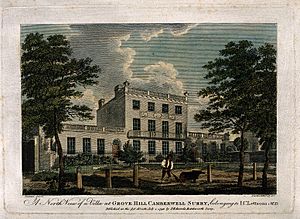George Samuel facts for kids
George Samuel was an English artist who lived around the late 1700s and early 1800s. He was a talented landscape painter. He worked with both oil paints and watercolours. George Samuel was also known for drawing detailed pictures of places, like maps or views.
About George Samuel
George Samuel showed his paintings every year at the Royal Academy. This was a very important art exhibition in London. He exhibited there from 1786 until 1823. He also showed many artworks at the British Institution. His paintings often showed beautiful places in England. These included areas like Cornwall and Westmorland.
In 1799, he joined a sketching group led by the artist Thomas Girtin. George Samuel was also one of the first artists to use a printing method called lithography. He sadly died in or soon after 1823. His death was an accident. An old wall fell on him while he was drawing outdoors.
His Artworks
In 1789, George Samuel painted a famous scene. It showed the River Thames from Rotherhithe during a very cold winter. The river had frozen over, which was quite unusual. This painting became very well-known.
Some of his other artworks were turned into engravings. An engraving is a picture made by carving an image onto a metal plate. These plates are then used to print copies. His painting of Holland House was engraved for a book called Select Views of Seats. His view of Windsor Castle was also engraved for Royal Residences. Other works appeared in magazines like the Copperplate Magazine (1792) and The Itinerant (1799).
George Samuel's watercolour paintings were inspired by the artist Paul Sandby. In 1799, Samuel also created drawings for a poem. The poem was called Grove Hill. It described the home of a person named John Coakley Lettsome.



